Systems can always be improved. But a system intervention must be well planned, or the cure may prove worse than the disease. In improving company systems, you work outward from first principles. It starts with vision and mission, assuming they are in alignment with market truth. If they are, you can turn to your company’s bounded purpose — the most critical imperatives for your company over a defined range of time. This purpose must address the two imperatives of any company: to be generative, and to be adaptive.
The Generative and Adaptive Imperatives
The first imperative is to be generative. A market truth lies waiting to be discovered — some pain that must be solved, some need fulfilled. The generative business seeks out that truth. You sense there’s a new way to address the pain or meet the need. Digital innovation has created an opening. Ideation leads to innovation, and innovation to iteration. The sausage-making is messy. Pivots abound. But in time market truth emerges, layer by layer. Your first customers co-create the product with you — through praise and complaint, rejection and commitment. Slowly but surely, something begins to stick.
In a world of accelerating digital change, markets, segments and personas live in a fast-moving ecosystem. Your target customer’s customers, competitors, suppliers, investors and economic conditions are in constant flux. As such, market truth is in motion. The rate of change in the marketplace is usually greater than the rate of change in your product, resulting in gaps. The generative enterprise is vigilant in detecting these gaps and working to close them.
The systems most closely tied to the generative imperative are strategy, planning and architecture; product discovery; product management; and the revenue engine. Actors who work in these systems must live comfortably with alternating cycles of variation that widen and then narrow as they pursue truth in motion. Their job is to move down the narrowing path towards the “answer,” and then leverage that answer until it ceases to perform. The answer might be your product, your top priority segments, your key personas, your messaging or your message distribution choices. When answers weaken, the range of hypotheses must widen again, and the narrowing path (the test / iterate / optimize cycle) resumes.
Generative value breakthroughs emerge from teams of 10Xers immersed in an intensely customer centric state. You watch, listen and learn. You connect with the customer’s challenges on both a rational and emotional level. You care. You are committed to discovering and delivering customer-defined quality. This gives you the stamina to slog through endless iterations on the journey towards truth. Solutions start off imperfect and incomplete; it takes more time than you ever expected to vector towards solving pain and meeting need. But for the successful company, persistence bears fruit. You achieve Minimum Viable Product (MVP). Traction emerges. Charter customers move towards happy, and new ones sign on. Success beckons.
As it does, the riddles become more interesting. For the early stage company, success yields complications. More people must be hired. Workflows break down and must be redesigned. Duties must be segmented. Manual processes must give way to automated processes.
This leads to the second purpose of an enterprise — to be adaptive. The adaptive imperative will persist throughout your life as a company. Three forces drive the need for adaptation: rigidity risk, scaling pressures, and efficiency pressures.
Resilience is the most important of the three adaptive imperatives. It is the antidote to rigidity risk. A rigid enterprise is brittle. It can’t adapt to change. As you look to improve your systems, it is important to assess enterprise-level resiliency. It is different than efficiency — and much more important. Resilience is the capacity of the system to bring stocks to their desired states in a self-organizing way. It requires two things: feedback loops that deliver the right data to teams, and teams that are self-organized (so they can quickly act on the data). A resilient enterprise has a web of balancing and reinforcing feedback loops made visible to decision makers, operating over different time horizons and different dimensions (such as people, workflows, technology and money flows). The balancing and reinforcing feedback loops in resilient systems exhibit redundancy; there is no single point of failure. These feedback loops clarify current state, and motivate actors to act consistent with enterprise purpose. Meta systems (governance, strategy / planning / architecture, culture, DataOps and engineering) exist to increase resilience in the enterprise.
An example of a company that has built resiliency into its systems at scale is Starbucks. It has built sensors into the market to capture customer feedback, such as through its mobile apps. It has built IoT solutions to deliver feedback on oven and refrigerator temperatures, to support safe food preparation. It has a strong data driven culture .It tracks employee satisfaction, and its leaders act on the feedback to continuously improve. Its technical teams are self-organized and pursue disciplined agile delivery leveraging reactive microservices architecture.
You tend to discover the limits of a system’s resilience only when you surpass them. In the pursuit of efficiency, it is important not to eliminate redundancy in a system — for to do so would be to disrupt the system’s resilience and introduce rigidity. This is a common mistake in mature enterprises. Having cut the fat and wanting more, they cut muscle. Never forget: resiliency is always more important than efficiency.
Scaling pressures force you to confront limits to growth. To break through the limiting factors, you must adapt. In the beginning, there is a small founding team. All work is consolidated in the founding few. Workflows are undesigned and chaotic. Most of the work is done manually. Nothing is measured. Consolidated, chaotic, manual and unmeasured — this is the starting point for every new company. But as time goes on, it’s no longer possible for one person to design and engineer the product, while another person is your walking, talking revenue engine. The “chief cook and bottle washer” approach quickly degrades. Hacks and gut instinct become inadequate coping tools.
The pressures of scaling cause you to break work into parts. You organize parts into a rational sequence. You establish rules to guide the interactions between them. The imperative to adapt results in internal change — in roles, staffing, workflows, tools, technology development priorities and financial requirements. These adaptations make you more scalable.
While truth is in motion in relationship to the marketplace, truth is at rest inside some of your company’s domains — the low variation domains. Consider the accounting system. Accounts payable and receivable workflows stay relatively stable no matter stage of company, though the scale of accounting operations might change. This stability enables you to introduce efficiency. This is achieved by reducing steps and automating low-variation activities. Wherever stability exists, you can gain technology leverage. Let machines do the work a monkey could do. High variation domains, on the other hand, require the human mind for problem-solving, hypothesis generation and testing.
Done well, improvements to efficiency don’t just save money — they improve quality. That’s because for every step in a process, there is the risk of error. If you reduce steps you reduce errors. This is a win for the customer, your employees and your investors. However, this only works when the underlying process remains aligned with business purpose. In a world of constant change, the risk that process gets out of sync with business purpose rises. As such, the In The Loop leader watches like a hawk to make sure process is always in service of its master — purpose. It is all too easy for process to become the thing: “I’m a great leader because I improved the process.” No. You’re a great leader if you improve the business outcome.
At each stage on the scaling path, different systems emerge as bottlenecks to growth. Time and again, you mobilize to make these systems ready for the demands that will be placed upon them. If you don’t, they will soon be overwhelmed. And so it goes — the generative imperative leads to the adaptive imperative, which leads back to the generative imperative, and back again — in an upward spiral towards the sky.
This upward spiral is comprised of four stages: the first two generative, and the second two adaptive. First there is a value breakthrough; then value optimization; then resiliency, scaling and efficiency breakthroughs; and then resiliency, scaling and efficiency optimizations.

Leading into every breakthrough and optimization, there is a hypothesis generation / test / iterate / optimize cycle. At first there is a wide variation in ideas. But then, as you test and discover signal, you narrow in on truth — like this:

It is important to acknowledge the reality of variation. Periods of high variation are periods of underperformance. You can’t perform well until you narrow in on truth. But truth is rarely instantly accessible.
Leaders and teams must carve out time to test theories of truth — hypotheses. Then you need healthy feedback loops in place so that you get the necessary feedback to iterate and optimize. In The Loop leaders work to improve feedback loops, and to act objectively on data. Snap decisions based on gut are sometimes right, but often wrong. Design your decision making systems in a way that accounts for variation, and that allows the time to narrow towards truth.
In the at-scale fit systems enterprise, the generative and adaptive imperatives look like this:
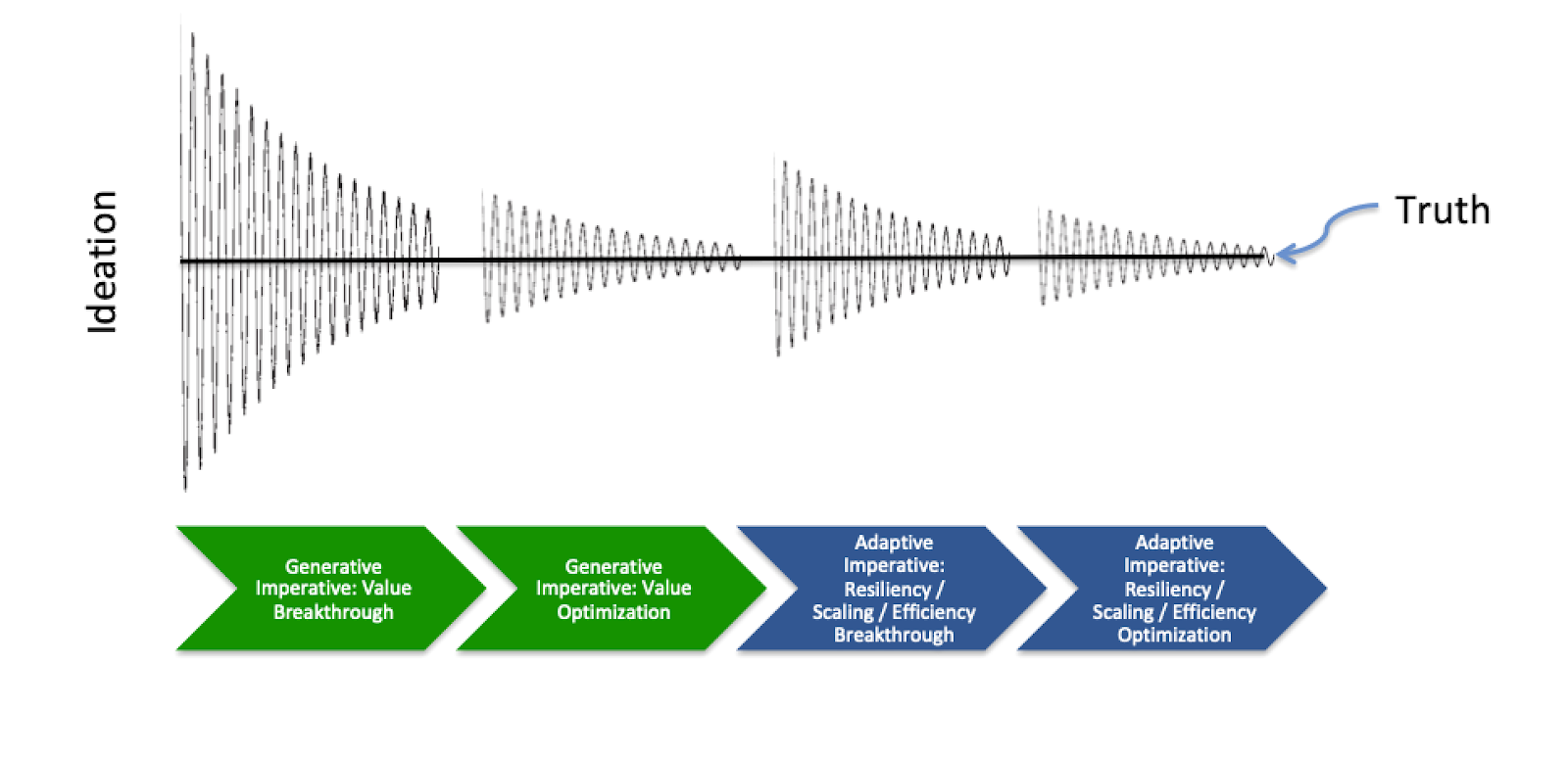
As a tech company CEO, you must assess your generativeness. Have you achieved a value breakthrough sufficient to power your company towards outsized growth? Is there strong “must have it” product / market fit? If so, you can shift your focus to the other three chevrons. But if not, your primary resources must remain dedicated to achieving the value breakthrough.
Always work left to right: value breakthrough first.
Too many companies get “close enough” with their product. They achieve some sales traction, and quickly conclude they have nailed the value breakthrough. But the signal is tepid. Throwing caution to the wind, egged on by impatient investors, they invest scarce capital into scaling sales or adding new products without optimizing the core value proposition, while churn slowly rises in the background. Eventually, revenue growth flattens out as new sales match new churn — just as the money runs low. Without an investor story, a negative reinforcing feedback loop kicks in.
Achieving Generativeness — How You Know
Existing value is not proof of generativeness. The presence of existing customer value simply proves that a previous generation of leaders was generative. A system’s current effectiveness is judged by its current behavior and results. Generativeness is proven by the customer’s response to your attempts to increase product value. Only the customer can call a system’s output generative. Generative acts are required now, just to fill the ever-growing value hole. An enterprise is only generative when it is actively creating new value.
So how do you know when the enterprise’s stock of customer-perceived value is rising? You measure the status of the system’s stocks. The first decision is to decide which stocks to measure. This is, perhaps, the most important decision of all. You are guided by the recognition that market truth is in motion. Your job is to track its movements and to act in response. You test a value creation hypothesis, and measure again — continuously seeking proof of increased value. The feedback loop keeps you honest.
In the fit systems enterprise, generativeness is present in three operating systems: the product discovery system, the product management system and the revenue engine system. Here are some stocks to track in each.
Product Discovery
In the final step in the product discovery system, you need to confirm a true value breakthrough through sales to beta customers. Proof of breakthrough can be found in proof of conviction lock (“I’m convinced — sign me up”) and advocacy lock (“I’m a raving fan”). These are the two proofs of customer perceived value. To ascertain these, you can track indicator stocks — such as efficient purchase, rates of use, expansion spending, customer satisfaction and retention, like this:

Time graphs confirm whether progress is being made:
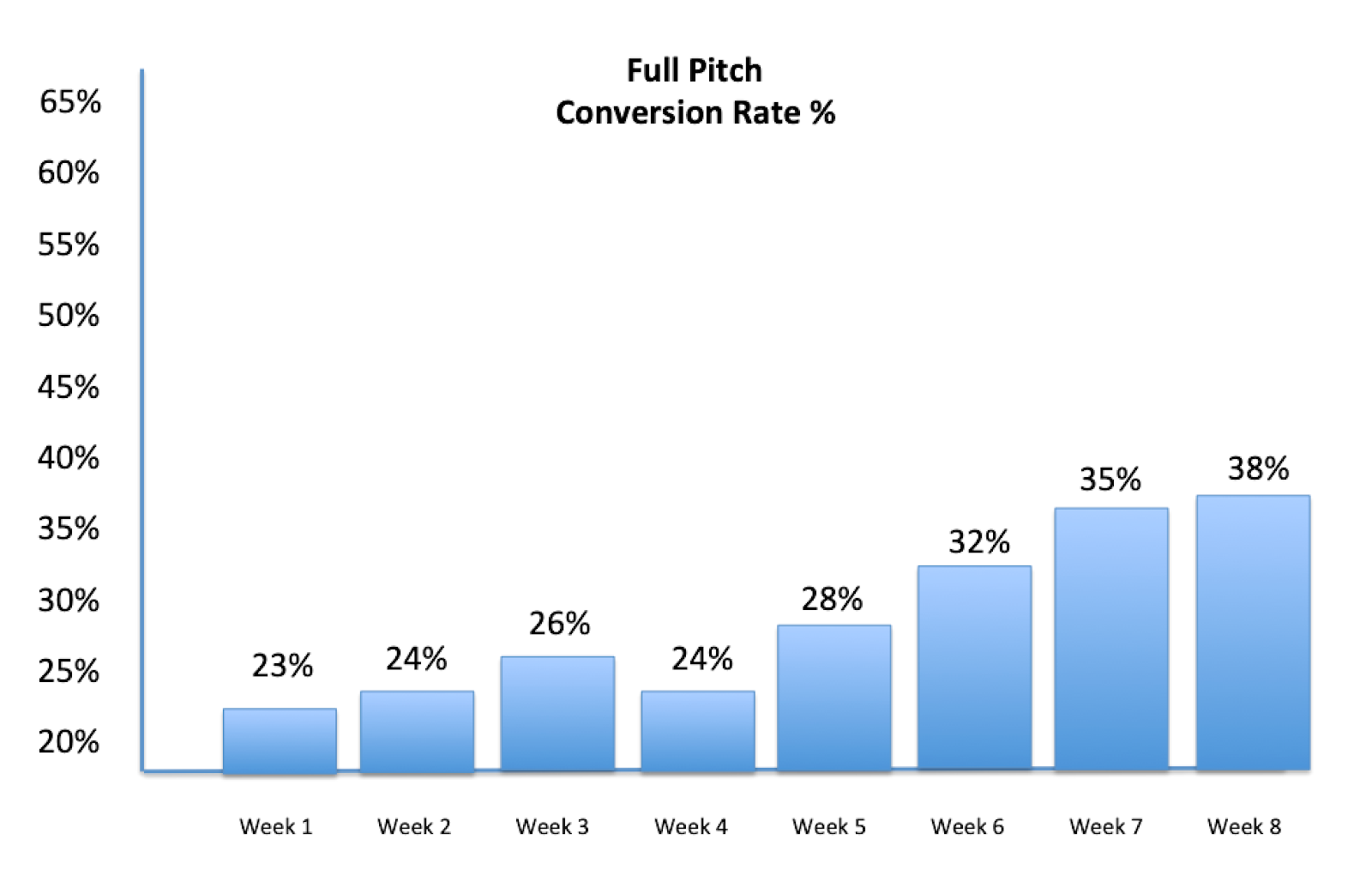
This creates a feedback loop, which can be balancing or reinforcing. If your measure of product / market fit exceeds a defined threshold, then you can proceed to full production and rollout — a reinforcing loop. If it falls below the threshold, it is a balancing feedback loop, like this:
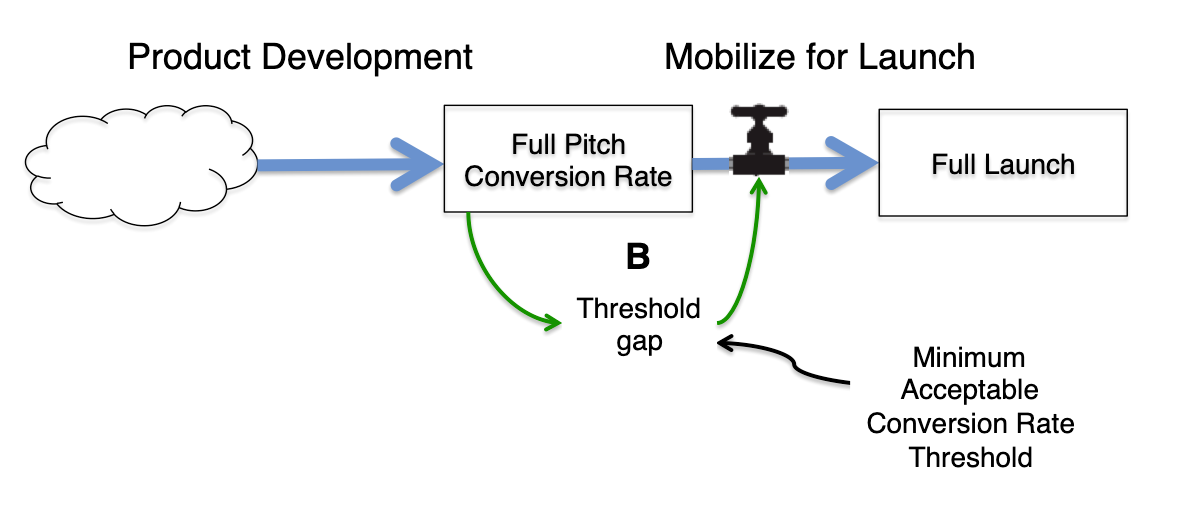
Customer perceived value of your company overall could theoretically be tracked by measuring brand equity. But early stage companies have no brand awareness, let alone brand equity. And for the later stage company, its stock of brand equity reflects a commingling of all its products and services. That’s why product-specific indicators are better. These include the rate at which a full decision maker pitch converts to a sale. For a B2B SaaS business, you would want to see at least 30%. Other product-specific indicators include the average use of the product (at least three times a day?) by intended users, or the percent of intended users using the product (90%?) or a net promoter score ( 50%?). These are far better indicators that your product discovery output has been generative.
Product Management
In the product management system, the system purpose is continuous value optimization. As such it can be a more nuanced task to confirm value. After all, product management is comprised of a continuing series of slight value optimizations over time. The overall customer perceived value of the product is decisively impacted by the accumulation of these value optimizations, but it is hard to separate which ones have the greatest positive impact. It requires that you first specify the customer value objective of each feature you develop. This objective can usually be expressed in terms of expected speed to value and level of expected use. Some features may directly impact purchase expansion. Like this:

Revenue Engine
A customer’s perception of the value of your product can be influenced by messaging and engagement. When your messages create heightened awareness of an unmet need, you are directly impacting the customer perceived value of your product. Proof of value generation is in the campaign conversion rate and unit economics (LTV / CAC = lifetime value / customer acquisition cost), like this:
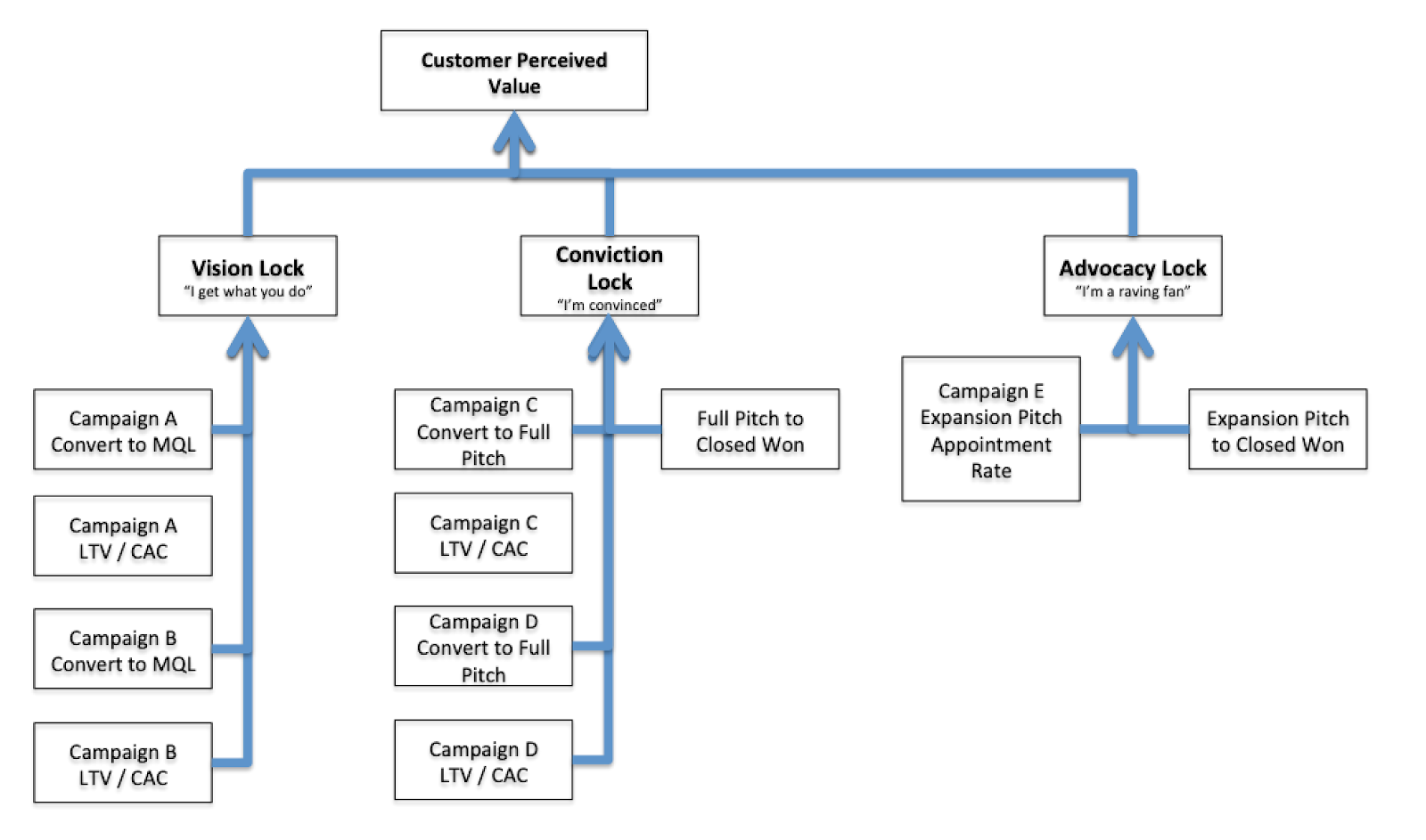
Achieving Adaptiveness — How You Know
It’s the same for adaptiveness. You prove that an act has been adaptive by the outcomes you achieve. Every operating system and meta system in the enterprise can be uplifted through adaptive acts. There are three dimensions of adaptiveness, ranked in order of importance: resiliency, scalability and efficiency.
Resiliency
Of the three types of adaptive acts, resilience is hardest to measure, but the most important. Resiliency improves when a system’s feedback loops are improved and diversified, and when teams acting on these feedback loops are self-organized and purpose-driven. A system is more resilient when it has no single point of failure, when dysfunctions can be quickly detected and addressed, and when adaptations to change occur in a self-organizing way.
As you evaluate a system map, look for redundancy. Redundant systems are resilient systems. Is there one key employee on your technical team whose departure would cost you irreplaceable knowledge about a mission critical system? Training others in this knowledge would be an example of an adaptive act. Are you saddled with a technology monolith? Deconstructing the monolith into microservices would be an adaptive act. Is your organization monolithic? Reorganizing into small, cross-functional teams is an adaptive act. Does your management culture act as a benevolent dictatorship? Shifting to a more employee involved, self-organizing culture is an adaptive act.
All of these acts have the purpose of increasing resilience. But they must be measured by the business outcomes they achieve — not the activities, like this:
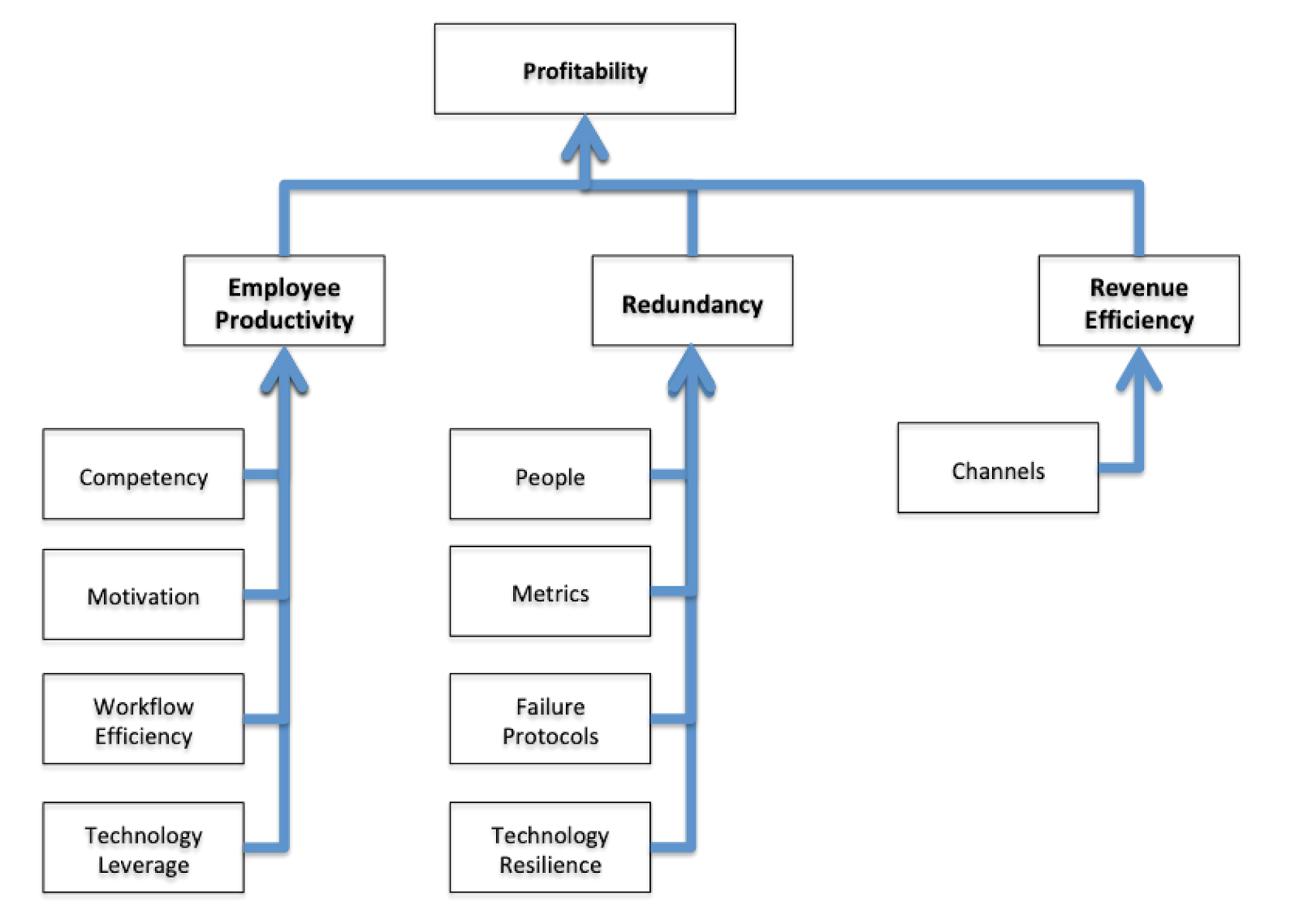
Each of these stocks can be measured. Competency is assessed by managers. Motivation can be assessed through employee surveys. Workflow efficiency is measured in cost savings and quality improvements. Technology leverage is measured in the improvement in workflow efficiency. You can measure the stock of people who hold “single point of failure” positions. You can measure the degree to which metrics have been implemented throughout the company to track performance. You can measure the capacity of technology to self-heal with failover protocols. And you can measure the number of alternative channels you have built to drive revenue growth. All of these measures track resiliency.
The meta systems exist to increase resilience in the operating systems. Their performance is measured by the degree to which they increase the autonomy, alignment and performance of self-organized teams.
Scalability
The scalability of your enterprise increases through actions in the areas of people, workflows and technology. For instance, if the number of people co-located in an office grows to the office’s capacity, you need to move to a bigger space. It’s not uncommon for workloads to rise undetected until some operational domain team becomes overloaded, causing customer service and morale to plummet.
As your company scales, you need to watch for this. You’ll need to make workflows more segmented, creating ever more atomic domains and domain teams. Sometimes a complete redesign and step change is required — such as when you move from a spreadsheet to a vendor based accounting system, or from QuickBooks to an industrial grade enterprise accounting system. Technology must be adapted to support these evolving workflows and to handle the volume, variety and velocity of data passing through. Technology in the fit systems enterprise exhibits low latency, high availability and high security. The acts taken to get there are examples of adaptive acts.
Efficiency
Workflows become more efficient when process steps are eliminated or automated. Efficiency is a good thing when it improves quality and saves money. But be careful. In a world of constant change, it is easy for a process to become out of sync with the desired business outcome. For instance, a procurement manager seeks to increase control over procurement so as to get better pricing and terms from vendors. It’s a step sure to save money. That’s efficiency, right? But if this new approval step causes delays in the purchase of critical materials, platforms and equipment, and if that results in domain teams being denied fast access to the capabilities they need to achieve real business outcome objectives, the process itself is flawed.
Efficiency is a proper goal to pursue once you are sure the process serves business outcomes. Even then, cost savings are not enough. A process change must leave quality at least constant — preferably improved — for the efficiency measure to be justified.
Digital Leverage
Companies become more generative and adaptive through digital leverage. This is true for all enterprises — from mining companies to Salesforce.com. The exact points of digital leverage will vary — the leverage available to a retailer will differ from that of the construction company, which will differ from the financial services company. But digital leverage is key to all, both in products and processes.
Just consider that mining company. Digital leverage is irrelevant in mining companies, right? Not so fast. In 2016, Accenture published a white paper on the digital transformation of mining companies. Here is one slide from that presentation:
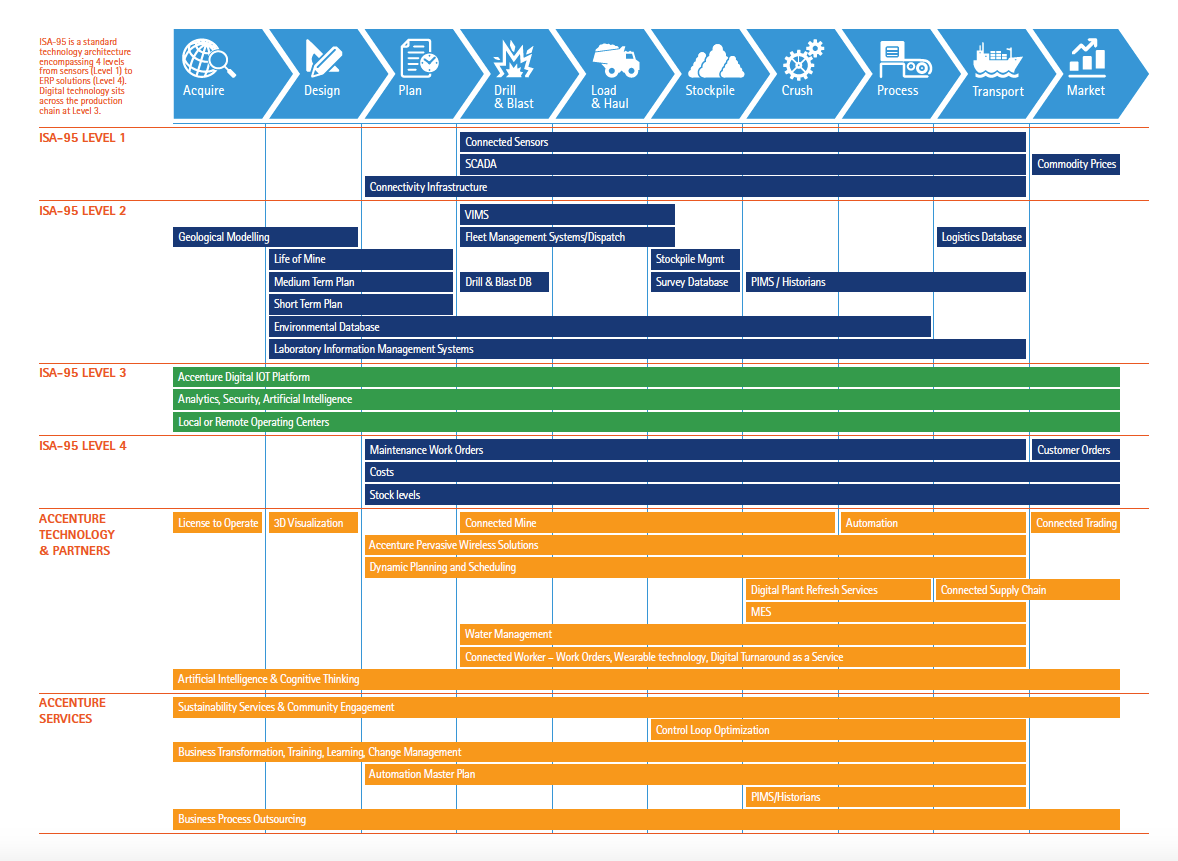
¹
For the mining company, digital leverage is available at every step in the value chain, in product as well as process. The point is that even in an enterprise that digs dirt out of the ground, digital leverage abounds. Every successful enterprise of meaningful scale must bring digital to the center in order to effectively pursue its generative and adaptive imperatives.
Summary
An In The Loop leader tends first to generativeness. Are you creating sufficient new value to keep customers and power your vision? This is always problem number one. Once this is assured, you can then focus on the adaptive imperative. But even here a priority order is important. Resiliency comes first. It is the most important adaptive priority. Work to increase system feedback loops and self-organization. The next priority is to increase scalability — by removing limits to growth. Only then do you turn to efficiency. You first confirm the process still serves enterprise purpose, then you work to make it more efficient.
As always, the generative and adaptive imperatives are best pursued by domain teams, attacking problems in a self-organized way. Your job as their leader is to set them up for success.
Notes
- Accenture, 2016, “Digital Mining: Connecting the mine from pit to port, from sensor to boardroom, for improved safety and productivity”. https://www.accenture.com/_acnmedia/PDF-26/Accenture-Resources-Digital-Mining.pdf#zoom=50
To view all chapters go here.
If you would like more CEO insights into scaling your revenue engine and building a high-growth tech company, please visit us at CEOQuest.com, and follow us on LinkedIn, Twitter, and YouTube.

